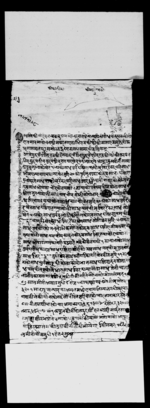A copy of a lālamohara from King Surendra to Jagadīśvaranātha reconfirming the purchase of kuśabirtās (VS 19[2]9)
ID: K_0469_0020
Edited by
Christof Zotter
in collaboration with
Rabi Acharya
Created: 2019-06-03;
Last modified: 2023-09-29
For the metadata of the document, click here
The accompanying edition, translation/synopsis and/or commentary are available under the terms of the Creative Commons Attribution-ShareAlike 4.0 International License
Abstract
In the lālamohara of which the present document is a copy, King Surendra reconfirms to the mahanta Jagadīśvaranātha different kuśabirtās in Ḍumrajyulā and Ḍāḍāgāū purchased from the rājagurus Raṅganātha Paudyāla and his brothers forty years earlier.Diplomatic edition
1211श्रीकालीका१1श्रीमहादेवको२1लालमोहर1रुजुदुरुस्तछ2स्हीडीट्ठाद्योतीप्रासाद[seal of Lokanātha]1सकलवुझीसकलवमोजिमनकलदुरुस्तछभनीसहीछापगर्नेमहंतछेत्रनाथजीकाचेलालोकनाथजी1स्वस्तिश्रीगीरीराजचक्रचुडमणिनरनारायणेत्यादीवीवीधवीरुदावलीवी
2राजमानमानोन्नतश्रीमन्माहाराजाधिराजश्रीश्रीश्रीमाहाराजसुरेन्द्रवीक्र
3म्साहावाहादुरसम्सेरजङ्गदेवानासदासमरवीजयि़नाम्¯¯¯ ¯¯¯¯
4आगेगुरुपंनडीत्राजश्रीरंगनाथपंडीत्गुरुपंन्डीत्राजश्रीःश्रीकीस्नापंन
5डीत्गुरु•पंन्डीतगुरुपंन्डीत्राजनाराये़न्पंन्डीतहरुले•आफ्नाकुसवीर्तासल्ल्या
6नाडुम्नज्युलाकोषेत्१।तस्कोसाधपुर्वदक्षिणपश्चीम्ऊत्तररैकरवारीसाध•
7औमदान्यावागवथान्याषेतमुरि२०कोपुर्वसुंनडकाकोरुषसाँधःदक्षिण
8ठुलोपहरोसाधपश्चीम्रैकरवारीसाधऊत्तरधैन्यानीपाषो•कोमेहेलको
9रुषसाध•औपाषा•चौरवीजपाथी•२जान्याकोपुर्वपस्चीमषोलासाधद
10छीणजुगन्याषोलीसाधपस्चीम्•षोलीकोदोभान्•[?][seal]कोभीरको[...]
11धऊत्तरवागवघन्याषोलासाधवागचौरषेतमुरि•१०तस्को•साधपुर्वरैक
12रषेतसाध•दछिणजुगन्याषोलीसाध•पस्चीम्ऊत्तररैकरसाध•सो[...]
13षेत•५तस्को•साधपुर्वठुलोढीकमेहेलकोरुषसाधदक्षिणपश्चि[...]
14¯ ¯१ ¯कागुठीषेत्साध•ऊत्तररैकरषेतसाधसोहीषेतमुरि•५तस्को
15साध•पुर्वचौरको•तल्लोढीकमेहेलकोरुषसाधदक्षीणसीमलषरको
16रून्याषोली•साध•पस्चीम्काफलकोरुषसाधऊत्तरहन्याचौरकाषोला•
17साध•औडाडागाउकावारीघड्यारीमकैकोवीजपाथी१जान्यातस्कोसाध
18पुर्वदारीम्कारुष•साधदक्षिणषीर्राको•रुषसाध•पस्चीम्मुलवा[...]
19साध•ऊत्तर¯ ¯२ ¯ ¯गुठीषेतसाधह्मांगाऊकावारीषेतवीजमुरि११जा[...]
20तस्कोसाध•पुर्वसांङ्दीषोला•कोदोभानसाधदक्षिणरुंनषोलासा
21ध•पस्चीम्स्योतेधारासाधऊत्तरदान्यागौडासाध•ये़तीचार[...]
22लाभीत्रकाजगापारप्रछिन्नसुक्रीवीक्रीगरीवेच्योतस्कोमोलसंम्वत्१[...]
23८७सालमीतीआषाडसुदी४रोज५काफार्छ्यापत्र•वमोजीम्मोहरु
24३२०१मादाङ्सल्यान्•काअम्वलमध्येरानागाऊवस्न्याजगदीस्वरनाथ
25वावाजीलेकीन्योतस्कोवकसौंनीषेतमुरिचारको•चारआनाकादरलेरु
26८।।।वीजपाथीचारकोचारआनाकादरलेरु१३।।।३/दसौदरु३२०।।।[...]
27ज्मारु३४२।।३/।।।१कप्तानकीर्तीवाहादुरसींराजभडारीमार्फतहा[?]
28हजुरदाषीलभय़ोवेचन्याकोदामपाकोकीन्याको•माटोपाकोआफ्ना
29षातिरज्मासंग•कीनुव़ावीर्ताजानीभोग्येगरईतीसम्वत्१९३९[...]
30लमीतीपौषसुदी१रोज२सुभ्म्¯¯¯¯¯¯¯¯¯¯¯¯
Synopsis
[1r]
The lālamohara of which the present document is a copy was issued by King Surendra on Monday, the 1st of the bright fortnight of Pauṣa in the [Vikrama] era year 19[2]91 (1872 CE).2 It confirms that the rājagurus Raṅganātha Paṇḍita (text: Raṃganātha Paṃḍīta), Śrīkṛṣṇa Paṇḍita (text: Srīkisna Paṃnaḍīta) and Nārāyaṇa Paṇḍita (text: Nārāyen Paṃnḍīta)3 sold the following kuśabirtās: in Ḍumrajyulā,4 Salyan (text: Sallyānā), [a piece of land measuring] 1 kheta and a pink cedar (madhāne) grove [together with] pasturage (bāgabathāna) [measuring] 20 khetamurīs; unirrigated grassland (pakhocaura) [measured as] requiring 2 pāthīs of seeds; a grove [together with] open grassland (? bāga caura) [measuring] 10 khetamurī; the same [kind of land measuring] 5 kheta[murī]s5 ; the same [kind of land measuring] 5 khetamurīs; in Ḍāḍāgāū, dry cropland and building land (bārīgadherī) [measured as] requiring 1 pāthī of maize seeds; and, in Hyāṃgāū, dry and wet croplands (bārī kheta) [measured as] requiring 11 murīs of seeds.
According to a quitclaim deed (phārchāpatra) issued on Thursday, the 4th of the bright fortnight of Āṣādha in the [Vikrama] era year 1887 (1830 CE)6 , Jagadīsvaranātha Bābājī (see Commentary below), then living in Rānāgāū, in the district (ambala) of Dang [and] Salyan, purchased the landholdings for the sum of 3,201 moha[ra]ru[paiyā̃]s. The governmental fee on the birtā transaction (baksāunī) for the land measured in khetamurīs, 8 [mohara]ru[paiyā̃]s 3 [sukās], and for the land measured in pāthīs of seeds, 13 [mohara]ru[paiyā̃]s 3 [sukās] 3 [ānās], plus the ten percent fee (dasauda), 320 [mohara]ru[paiyā̃]s 3 paisās7 1 dāma, in total 342 [mohararupaiyā̃s] 2 [sukās] 3 [ānās] 3 [paisās] 1 [dāma], was presented to the government through (mārphat) KaptānaKīrtī Bāhādura Sīṃ Rājabha[ṇ]ḍārī.
Commentary
As Véronique Bouillier has aptly observed, the document comes from a period in which the monastic institution founded by Bhagavantanātha was firmly established and the siddha's successors had further expanded the properties and influence of the monastery by purchasing landholdings to supplement the birtās granted by different kings to the founder (Bouillier 1991: 160). The mentioned quitclaim deed of VS 1887 was issued not in the name of MahantaJagadīśvaranātha, as the present document suggests, but in that of his guru's guru, Mahanta Rūpanātha (see the edition of the phārchāpatra in Naraharinātha VS 2022: 462; cf. Bouillier 1991: 160). However, it was seemingly Jagadīsvaranātha who saw the necessary formal procedure of the transaction to its end by paying the baksāunī and dasauda.
While the quitclaim deed, more than forty years older, briefly mentions only the localities of the purchased birtās and the sum of 3,201 silver rupaiyā̃s,8 the later confirmation by the king is more detailed (see above), defining also the borders of the different plots of land. Unfortunately, many of these details remain unclear, not least since the copy edited here and Naraharinātha's edition sometimes vary greatly.9
The copy, attested by ḌiṭṭhāDyotīprasāda and Mahanta Chetranātha's disciple, Lokanātha, belongs to a batch of copies that was probably prepared in 1907 (VS 1964) to be sent along with a petition (bintīpatra) submitted by Lokanātha to Kathmandu (see K_0469_0033).

